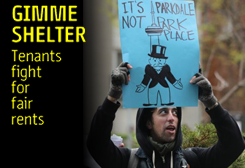BOOK REVIEW
B.C. without unions would be like B.C. without the Rockies

On the Line: A History of the British Columbia Labour Movement
Rod Mickleburgh
Harbour Publishing (2018)
B.C. IS UNION COUNTRY. ALWAYS WAS. ALWAYS WILL BE. And that’s a good thing. Rod Mickleburgh convincingly proves this in his new book On the Line.
Mickleburgh tells the story of 150 years of worker activism in B.C. It is a story of militant and continuous class struggle, union building and desire for social solidarity that is unique in all of Canada. It also is a story of how labour activism itself shaped day-to-day life in B.C. far beyond any workplace.
Mickleburgh’s history includes BC’s first ever strike, by miners on Vancouver Island in 1850, the creation of the first trade union by bakers in Victoria in 1859, as well as the latest victory for the BC Teachers Federation in the Supreme Court of Canada last year on the issue of collective bargaining. This is not a dusty academic history, but a book written in a lively, engaging style. “On the Line” also contains around 200 archival photos to help bring the events it describes to life.
Solidarity against state-corporate violence
The early strikes covered by Mickleburgh include a fishermen’s strike in 1893 when white and indigenous workers fought together, and the bitter two-year coal miners’ strike on Vancouver Island, which lasted from 1912 to 1914. The miners’ strike resulted in the army being called out with bayonets and guns. Even as they confronted state repression by armed police and volunteer militias, workers displayed a tremendous degree of solidarity.
In 1918, when a constable shot labour activist Ginger Goodwin, who refused to be conscripted into the First World War, workers in Vancouver responded by launching a general strike that brought the city to a standstill.
Racism and division
Mickleburgh documents how the racism towards Chinese workers and First Nations workers during the early decades of the 20th century encouraged by some trade unions undermined solidarity and weakened the movement. Rather than blaming the bosses for increased exploitation, organizations like the Asiatic Exclusion League in 1907 promoted the idea that wages were being driven down by Chinese workers. The two main goals of such organizations were to restrict Chinese immigration to Canada and keep non-white workers out of the labour market.
Mickleburgh’s research shows that First Nations and Chinese workers played a critical role in the early decades of BC’s industrial development. “Coal would not have been mined in the 1840s and ‘50s, export sawmills would have been unable to function in the 1860s and ‘70s, and canneries would have had neither fishing fleet nor fish processors in the 1870s and 1880s without the widespread participation of aboriginal people,” stated historian John Lutz, who is cited in Mickleburgh’s book.
On the railways, Chinese labourers sacrificed many lives to extend the rail network. Mickleburgh mentions the story of Wong Hau-Hon, who wrote in the 1920s about his experiences. “I first came to Canada in 1882,” wrote wong. “We debarked at Westminster. I set out on foot with about four hundred Chinese to join the railroad construction crews at Yale. We had worked only two days when the white foreman ordered our gang to move to North Bend. It rained all day. We were wet and cold. Some arrivals, unaccustomed to the Canadian climate, sickened and died, as they rested beneath the trees or lay on the ground. When I saw this, I felt miserable and sad.”
When workers seized the initiative to unite across racial lines, the results were powerful. In 1906, First Nations dock workers formed a local as part of the International Workers of the World which became known as the „bows and Arrows.“
Mickleburgh also recounts the story of a united struggle by Canadian and Chinese workers in 1938-39 on Texada Island in the face of bloody repression by the Pacific Lime company, backed up by the state. Led by the International Woodworkers of America, the 11-month strike saw the police violently assault strikers and their leaders. “It turned into a strike like no other, where authorities acted as a law unto themselves, reminiscent of the Deep South,” Mickleburgh writes. “Along with the usual trappings of a company store and company housing, PacLime owned virtually all property and every facility in the community. During the strike, children had to obtain a pass to cross company roads merely to attend school. Strikers were denied access to telephone and telegraph services. When union leaders were able to find a phone, police monitored their calls. Strikers were followed and often thrashed by company thugs if they wandered too far astray.”
Workers win
Despite suffering bitter defeats in the major strikes of the early 20th century, determined workers’ struggles in the post-war period led to important improvements, as Mickleburgh explains.
One such struggle was the 1966 wildcat strike at Lenkurt Electric in Burnaby, when 257 workers walked off the job after a deal brokered by the International Brotherhood of Electrical Workers union was ignored by a senior manager. Workers were particularly furious at the company’s unwillingness to enforce an overtime ban.
management responded ruthlessly, firing all of the striking workers and providing scabs with a police escort to cross picket lines. Numerous scuffles broke out on the picket line, and the company obtained a court injunction against picketing. This was a tactic used by the bosses for decades, who were invariably backed by the courts, to intimidate workers by threatening them with huge fines and prison terms.
Soon after brutal clashes on the picket line May 11, 1966, the strike came to an end on the company’s terms. “The company was maintaining production, the police were allowing the strike-breakers to get into the plant –it was just really, really tough,” Mickleburgh said. The deal eventually forced on the workers failed to guarantee all of them employment. As if to add insult to injury, 15 workers were fined $3,000 for breaching the court injunction, and two local labour leaders were handed six-month jail terms.
However, the bitter defeat proved to be a catalyst for a major step forward following the election of the province’s first NDP government in 1972. “For the first time, they removed jurisdiction over picketing from the courts,” stated Mickleburgh. “They gave it to the Labour Relations Board, where it’s been ever since. It was a landmark decision in North America when they did that, and, basically, most provinces have followed. And the Lenkurt dispute was part of the outrage that led finally to the legislation being changed, and the role of the courts was diminished in terms of punishing union leaders and workers.”
Optimism for the future
Mickleburgh acknowledges towards the end of his book that unions today aren’t the force they once were. But he maintains an optimistic view for future struggles to defend workers’ rights.
The decline of industrial jobs in BC, and across Canada, has weakened the main source of support for the powerful unions described by Mickleburgh in the early part of his book. In addition, he points out that the expansion of the service sector and emergence of the so-called “gig economy” have made organizing workers much tougher.
But the struggle against injustice and safe working conditions goes on, meaning that workers will have to fight back. Among recent tragedies in the workplace, Mickleburgh refers to the deaths of three workers at a mushroom farm in Langley in 2008. “The employers never stop trying to roll back conditions if they can,” points out Mickleburgh. He continues, “[T]here is no sign of trade unions becoming extinct. They remain a key force protecting and advancing the cause of all workers in a no-holds-barred economy.”











Add new comment